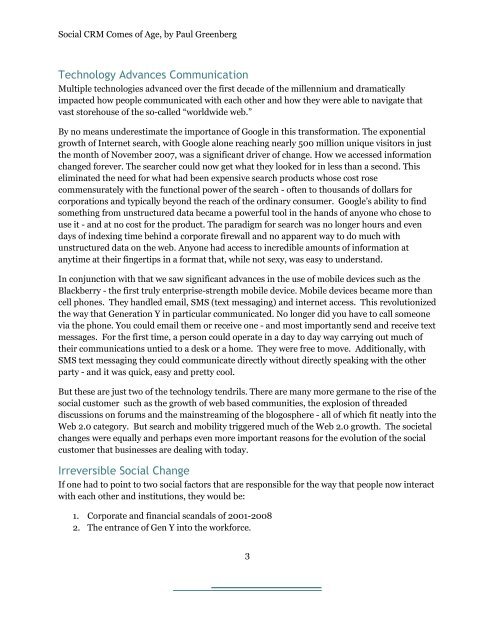Social CRM Comes of Age (PDF) - Oracle
Social CRM Comes of Age (PDF) - Oracle
Social CRM Comes of Age (PDF) - Oracle
- No tags were found...
You also want an ePaper? Increase the reach of your titles
YUMPU automatically turns print PDFs into web optimized ePapers that Google loves.
<strong>Social</strong> <strong>CRM</strong> <strong>Comes</strong> <strong>of</strong> <strong>Age</strong>, by Paul Greenberg<br />
Technology Advances Communication<br />
Multiple technologies advanced over the first decade <strong>of</strong> the millennium and dramatically<br />
impacted how people communicated with each other and how they were able to navigate that<br />
vast storehouse <strong>of</strong> the socalled “worldwide web.”<br />
By no means underestimate the importance <strong>of</strong> Google in this transformation. The exponential<br />
growth <strong>of</strong> Internet search, with Google alone reaching nearly 500 million unique visitors in just<br />
the month <strong>of</strong> November 2007, was a significant driver <strong>of</strong> change. How we accessed information<br />
changed forever. The searcher could now get what they looked for in less than a second. This<br />
eliminated the need for what had been expensive search products whose cost rose<br />
commensurately with the functional power <strong>of</strong> the search <strong>of</strong>ten to thousands <strong>of</strong> dollars for<br />
corporations and typically beyond the reach <strong>of</strong> the ordinary consumer. Google’s ability to find<br />
something from unstructured data became a powerful tool in the hands <strong>of</strong> anyone who chose to<br />
use it and at no cost for the product. The paradigm for search was no longer hours and even<br />
days <strong>of</strong> indexing time behind a corporate firewall and no apparent way to do much with<br />
unstructured data on the web. Anyone had access to incredible amounts <strong>of</strong> information at<br />
anytime at their fingertips in a format that, while not sexy, was easy to understand.<br />
In conjunction with that we saw significant advances in the use <strong>of</strong> mobile devices such as the<br />
Blackberry the first truly enterprisestrength mobile device. Mobile devices became more than<br />
cell phones. They handled email, SMS (text messaging) and internet access. This revolutionized<br />
the way that Generation Y in particular communicated. No longer did you have to call someone<br />
via the phone. You could email them or receive one and most importantly send and receive text<br />
messages. For the first time, a person could operate in a day to day way carrying out much <strong>of</strong><br />
their communications untied to a desk or a home. They were free to move. Additionally, with<br />
SMS text messaging they could communicate directly without directly speaking with the other<br />
party and it was quick, easy and pretty cool.<br />
But these are just two <strong>of</strong> the technology tendrils. There are many more germane to the rise <strong>of</strong> the<br />
social customer such as the growth <strong>of</strong> web based communities, the explosion <strong>of</strong> threaded<br />
discussions on forums and the mainstreaming <strong>of</strong> the blogosphere all <strong>of</strong> which fit neatly into the<br />
Web 2.0 category. But search and mobility triggered much <strong>of</strong> the Web 2.0 growth. The societal<br />
changes were equally and perhaps even more important reasons for the evolution <strong>of</strong> the social<br />
customer that businesses are dealing with today.<br />
Irreversible <strong>Social</strong> Change<br />
If one had to point to two social factors that are responsible for the way that people now interact<br />
with each other and institutions, they would be:<br />
1. Corporate and financial scandals <strong>of</strong> 20012008<br />
2. The entrance <strong>of</strong> Gen Y into the workforce.<br />
3

















